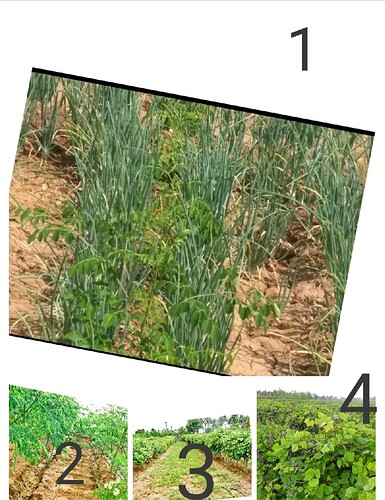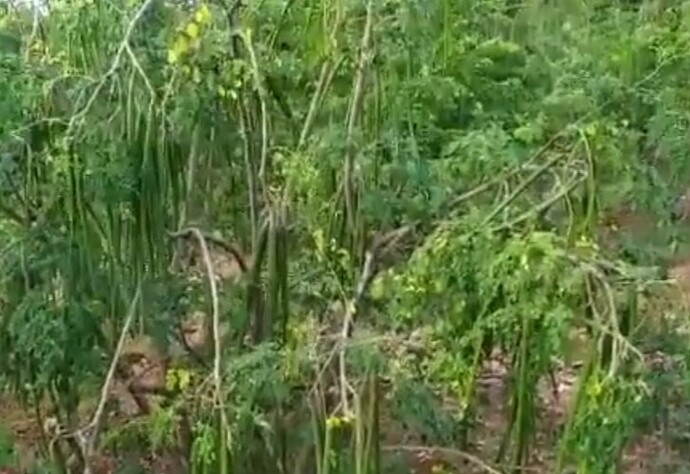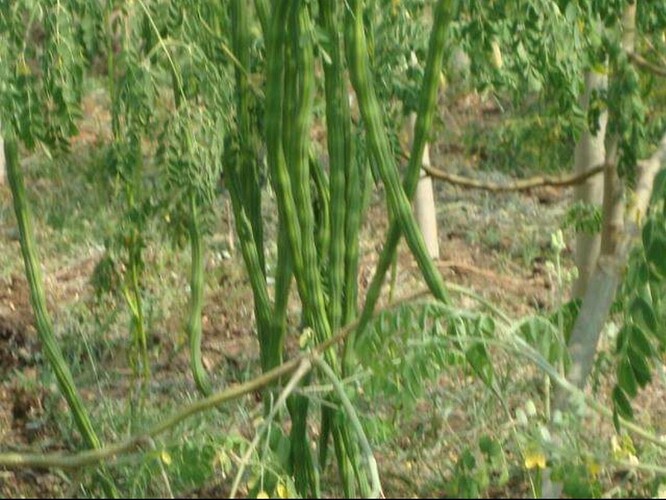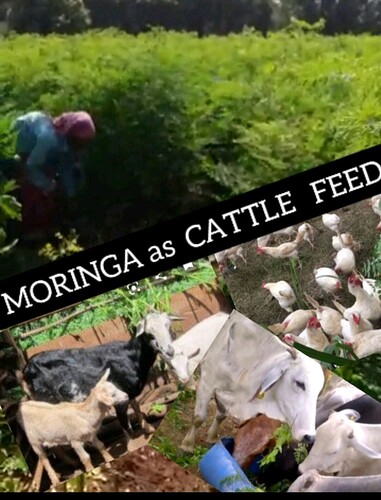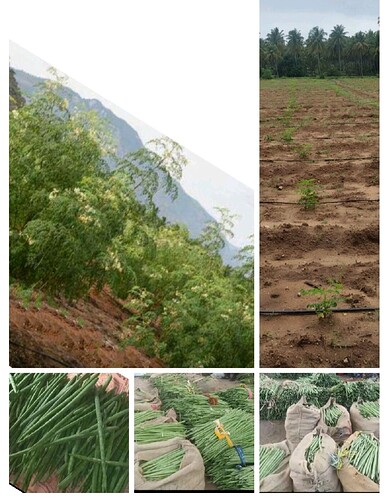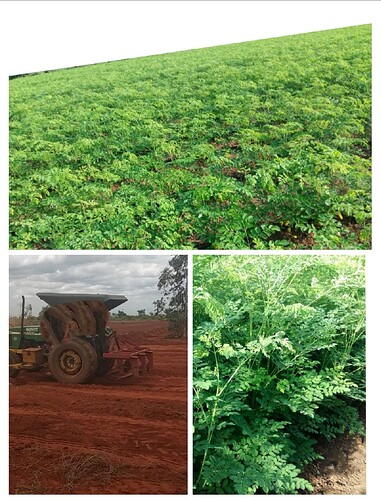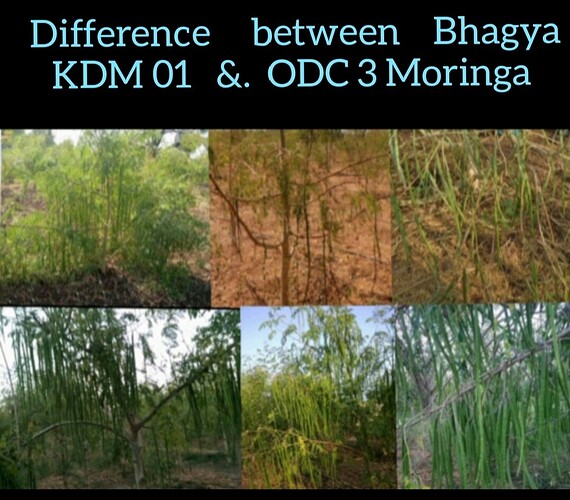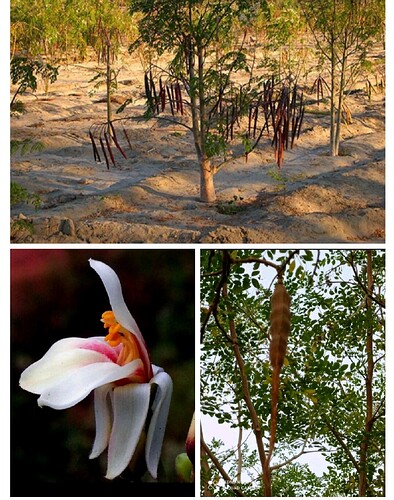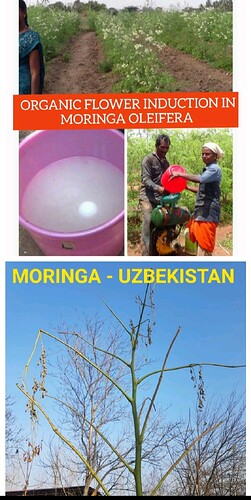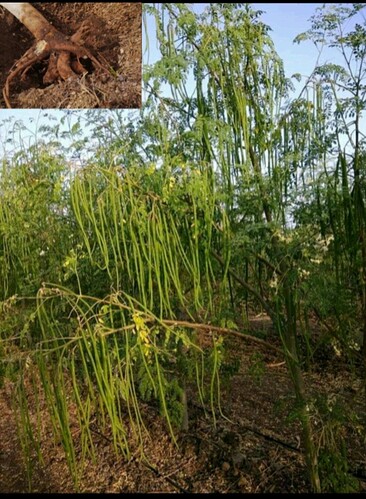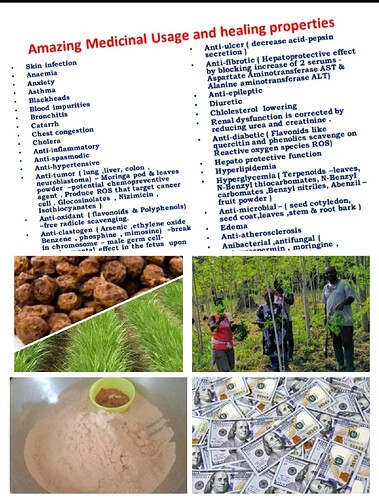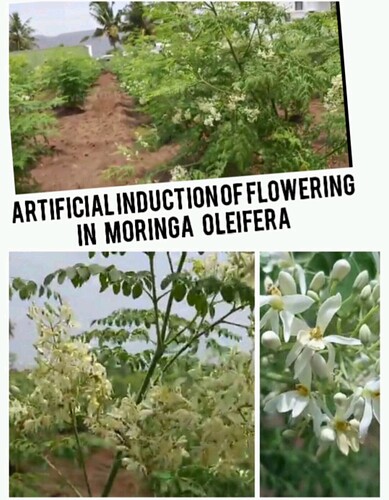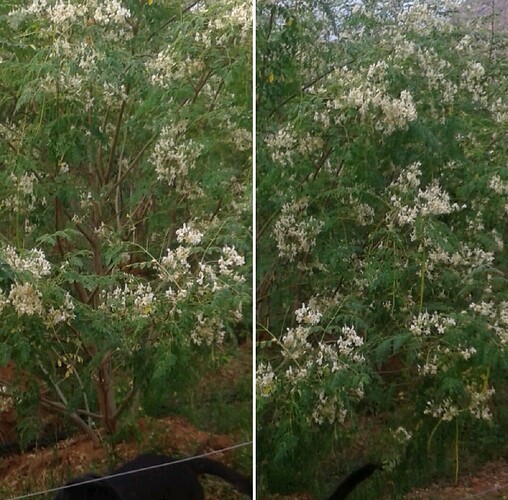MORINGA BASED RELAY CROPPING
Moringa was planted in Onion as intercrop
Onion was harvested before moringa has grown up to cast shadow over onion .
When Moringa was setting fruits , lab lab beans were planted along the rows of moringa .
After the harvest of moringa pods , moringa trees were cut back to 4 feet height to provide support to trailing creepers of lab lab beans
When harvest of lab lab beans are completed , Moringa has sprouted again to grow and bear pods again .
Land was plowed only once during planting of first crop onion and without further tilling moringa and lab lab beans were grown ,thus saving cost on land preparation .
In sustainable farming , crop intensity is increased by 300% while cost of cultivation is significantly reduced to maximise farm income.
The minimum tilling of land improves soil structure and fertility level and reduce soil erosion and soil microbial population is also building up ,thus enhancing natural soil fertility and carrying capacity of the land to support cultivation of sequence of crops with minimum intervention and cost of production .
When dairy cow is reared as in integrated farming system , the moringa leaves provide excellent fodder that increases the yield of milk by 30% more and hauls of lab lab bean also provide dry fodder
OFF SEASON FLOWER INDUCTION IN ODC 3 DRUMSTICK FOR WINTER PRODUCTION OF PODS …
One issue with moringa farmers is " My moringa trees don’t produce pods when market price is very high in off-season, winter " . Market arrival of drumstick is either less or absent and consequent upon less supply than demand ,price goes up high . Reasons are continuous heavy rain in South West Monsoon , low temperature , persistent soil moisture leading to sparse or no flowering in drumstick .
Here in this experimental demonstration field of ODC 3 drumstick at karmala Tehsil in Solapur district , 5 months completed moringa trees were made to flower by interventions like pruning of growing points , withholding of irrigation to create artificial stress in moringa plants , stopping nitrogenous fertilizer application and spraying of curd + asafoetida solution followed by panchagavya spray .
Now the vegetative growth is almost stopped and new floral shoots start emerging in leaf axils when balance between vegetative and reproductive phase is better achieved .
Even with half of the potential yield of pods ,better return is possible due to higher market price for drumstick in winter season .
Courtesy ; Chaithanya Gandhi ,Sheti udyog farmer producer company ,Solapur -7588610001
FARMER’S FRIENDLY MORINGA - ODC-3
Inspite of many ecotypes and varieties of moringa oleifera species viz . CO 1,2 , PKM1,2 , KM 1 , Dhanraj , GKVK 1,2,3 ,Anupama, Bhagya ,Ruchira, Rohit 1 , Jyothi,Moolanur, valayapatti , chemmurungai , Jaffna , kodikkal , yazhpanam, STX01,02 , kadumurungai , punamurungai ,palmurungai ,Durga,sharagva , Congo-brazaville , Malawi ,Mbololo, chavakacheri being grown all across the world , it is ODC 3 that is passionately grown by majority of Indian farmers for pods and foreigners like US and Australia for leaves . Bcoz
- Fast developing network of roots
- Early flowering like hybrid
3.More pods per tree - Thick and green pods
- Dual purpose - pod as well as leaf biomass production
6.Perennial varieties with life of over 50 years
7 Continuous flowering in suitable climate - Wide adoption to varied soil and climate
- Dark green leaves due to high chlorophyll
10 . Tasty pods and leaves due to less anti nutrients - Export quality pods
- Moderately tolerant to drought ,Pest and disease
13.suitable for hidensity planting as it respond very well to pruning
14.Big seed weighing between 0.35 - 0.40 gram and high Ben oil percentage .
Courtesy : Chaithanya Gandhi , Solapur, MH M/s shety Udyog farmer producer company 7588610001
![IMG_20201206_213926|690x346]
MORINGA ( DRUMSTICK ) AS CATTLE FEED - ODC 3 VARIETY AS BEST
" Animals become what they eat and we, in turn , become what we eat through them "
The developed countries with 1/3 of cattle population contribute 80% of milk whereas developing countries with 2/3 of cattle population contribute just 20% of milk production.
Moringa leaves as feed enhance cow’s milk yield by over 30% and weight by 43-60%
Moringa leaves with high crude protein with complete amino acids make cow grow more quickly ,with high digestibility and nutrient absorption .
Weaning cow is given moringa leaves 0.5-1.5% of its body weight . Or 25% of its daily ration . Meat cow is fed @ 50% of its daily ration with daily increase of body weight @ 0.4 - 0.6 kg
The goat body weight increases @60-75 grams a day
In poultry egg weight and yolk increases when moringa leaves are mixed @ 4% of daily ration
The high palatability , digestibility ,more amino acids , mineral nutrients and specifically less anti nutrient value of ODC 3 moringa makes one of the best alternative animal feed globally and more specifically in Australia .
Fast growing nature,more biomass production ,quick regeneration ability , perennial type with continuous production and wide adaptation to varied soil and climate make ODC 3 moringa the best
RED SANDY LOAM SOIL( EASY SOIL ) & MORINGA OLEIFERA
Red sandy loam soil with bulk density 1.55 - 1.75 g/ cm3 influences unhindered growth and more yield of moringa pods by influencing soil physical , biochemical and biological properties .
Soil aeration , water infiltration , available soil moisture , available soil nutrients , soil biological activities with exponential growth of microbial population that produce organic acids and amino acids and growth promoting substance allows moringa to produce network of roots that in turn determine development of strong productive framework of moringa tree canopy .
ODC -3 ,an indigenous variety of moringa oleifera species , identified and isolated from foothills of palani hill range in western ghat is penetrating USA for cultivation for the production of leafy biomass and Ben oil ( seed oil) production .
Post COVID 19 , building immunity and strong health has become a serious consideration of global community and Moringa comes as a choice nutraceutical to develop immunity in body .
Wide adaptation , easy acclimatization upon introduction into new environment , use of leaves in the processing of probiotic foods that is very much similar to alternative medicine by its functional attributes in building strong health and immunity.
MORINGA IN BLACK COTTON SOIL - A CHALLENGE ?
Growing moringa in black cotton soil is a challenge and toughest yet people succeed and make it possible .
CHALLENGES
Soil goes hard and plastic even in mild wetness , airspace in soil is replaced by water , poor seed germination roots struggle to grow and breathe resulting in poor uptake of water and nutrients, root rot disease , stunted growth , yellowing of leaves , sparse flowering ,lesser yield and twisted and uneven pods size and weight .
OVERCOMING CHALLENGES
1.Avoid sowing seeds during rainy season
2.Plow the black cotton soil to powder consistency after rain is over
3.Make beds 30 -45 CMS high and sow treated ODC 3 Moringa seeds only on top of the ridges
4.Sow 3 seeds per hill/ pit and retain 2 plants ,2 feet apart
5. Sow chillies or sunhemp as intercrop Bcoz after harvest , the roots of intercrop will leave sufficient airspace in black cotton soil for the roots of moringa to breath and grow . The sunhemp may be harvested and incorporated so that it prevents the soil becoming compact and keeps it loose .
6.Provide drainage channel to remove rainwater from the field . Too much wetness kills the roots and plants .
7.Always keep 800-1200 moringa trees in one acre to compensate for slow growth and get more pods .
Hi- Density Moringa leaf farming for higher productivity …
Due to ever increasing demand for certified organic Moringa leaf powder product in European and UK markets and continuous market promotion by Moringa Malawi , Kuli Kuli ( African entity ) & Organic Moringa India pte ltd etc moringa cultivation has been started in hi- density with 5 lac moringa plants in one Hectare land.
Around 300 MT of fresh biomass per ha is harvested in a year through 9 harvest done at 40 days cycle .
300 MT of fresh biomass ,after separation of stems and petioles provide 100 MT of leaves .This 100 MT of moringa leaves upon processing gives 12.5 MT of moringa leaf powder . At competitive market price of $ 10000 per MT , 12.5 MT moringa leaf powder is sold for Rs .92.50 lac .
However this much income is realisable through vertical integration of operations , both production and marketing by same firm .
Weight reduction & staying fit are the real concern of European people who use moringa leaf powder in curries , soup , stews , salads etc besides using it in the form of tablets , capsules as nutrceuticals .Morning and evening each 1-2 moringa capsules will reduce obesity and folds around hips disappear. Europeans are fast gaining awareness to eat more moringa leaf powder to stay slim.
WHY SPACING & DIRECTION IS IMPORTANT IN MORINGA FARMING ?
ODC 3 Moringa is sown 3 M wider between rows and 2.4 M wider between trees and PKM 1 is sown 1 M wider between rows and 0.5 M wider between trees and be it any variety , the rows are aligned east west as far as possible .Bcoz ODC3 grows profusely, quickly and continuously with strong branches reflecting perennial growth behaviour while PKM 1 grows fast only during early period until it produce flowers and fruit set with tender branches reflecting shrubby annual growth behaviour. And needs to be headed back to the ground , leaving 0.7-1.0 M high stem for allowing new spouts for the second year blooming and pod production .Where as ODC 3 grows continuously and needs only milder pruning after each harvest and no of pods and yield increase gradually year after year and it is headed back only when trees grow big enough to overlap .
The wind always blows from east to west and sun moves from east to west . So sun light penetration and aeration is good that is important in spurting heavy blossoms , reducing insect pest incidence .Also it prevents easy breaking of trees as the wind pass over freely without being obstructed . Another secret of successful moringa farming lies in sowing seeds in raised bed that act as cushion .
DIFFERENCE BETWEEN BHAGYA KDM 01 & ODC 3 MORINGA VARIETY
To clarify the doubt of one Bangalore based friend Mr.Raghuvamsa Arjun Shetty ,I post this here .
Bhagya KDM 01 is a breeder variety developed by UHS ,Bagalkot and released in 2011. It is a perennial moringa variety developed by improving on local moringa culture identified in chikkodi taluk , with the germplasm called PKM 3 donated by Periyakulam Horticulture college . Bhagya grows 2-4 M high , produces pods for 10-15 years but economical yield is possible upto 4-5 years , flowers showing up in about 110-120 days , small in size , pods medium in girth and length say 45-50 cms long , greenish pink skin .Bhagya is spreading type with many primary branches , horizontally placed with lower branches curving down at base and yields between 190- 1000 pods as the year progressing ( refer top layer of images - Bhagya KDM 01 ) and suited for hot dry region .
ODC 3 Moringa is a farmer identified variety ,occuring naturally at the foot hills of Western ghat in TN , surviving as long as 50 years , producing bigger size flowers in about 100-120 days , over 70 cms long green pods with fleshy pulp and girth , primary branches forming acute angle with main stem, heavy bearing with 300- 1000 pods per tree as the year progress( refer pic)
ISSUES IN PICKING RIGHT MORINGA VARIETY & TRUSTED SEED SOURCE"
General complaints from the drumstick growers are
1.My moringa trees are not flowering
2.My moringa trees produce small size pods / fruits & less no of pods
3.My moringa trees are not growing well etc …
Globally 13 different moringa species exist ,out of which two belong to India ( Moringa oleifera and Moringa concanensis ) and 11 belong to Africa but all carry same no of chromosome 2n = 28 like all human being living all across this earth with 2n= 46 chromosomes .
Out of 13 species it is only Moringa oleifera of Indian origins now being grown all over the world .
Even within Moringa oleifera species , wide variation exist , partly due to influences of environment across different geographical locations and partly due to intervention of research institutions .Reason for this wide variation is nature of reproductive mechanism in moringa - natural cross pollination.
So farmers can not tell apart varieties , genuine or fake by just looking at moringa seeds. By the time any farmer face issues , a good deal of time would have lost.
Picking right variety from the trusted source determines 50% of your success even before sowing moringa seeds in the field .Agronomical practices determines rest of the success
FERMENTED CURD TO STIMULATE FLOWERING IN MORINGA OLEIFERA
one of our LinkedIn connections from UZBEKISTAN country Mr.Aslidin lamented the climatic constraints that his moringa plant never flowered once and gone dead due to frost in winter.
Attention Mr Aslidin
The winter lasts for 4 months from NOV - FEBRUARY with temperature ranging between - 10°C to 15 °C and growing period there is limited to only 8 months from March to October , with temperature ranging between 25 °C - 35°C
Under this circumstances ,either sow moringa seeds in nursery bags in greenhouse/ hot house 2 months before in winter and tansplant in march .Or Treat the seeds for 72 hours and sow directly in soil under black mulching sheets .
Take fermented curd and mix it @ 20-30 ml in one lit water and have 200 lit spray solution per acre and do twice at 15 days interval starting at the end of April or first week of May . This will trigger enormous flowers in moringa . It takes 65 days from flowering to harvest of pods and yield will be taken before onset of winter in NOV.
Black mulching sheet / Trash mulching / cover crops protect roots of moringa in winter from getting killed due to freezing temperature . Following march , moringa will resume growth and produce yield
MORINGA STENOPETALA - AN INSIGHT INTO AFRICAN MORINGA SPECIES
There are around 13 moringa species found growing all over the world ,out of which Moringa oleifera of Indian origin is the only dominant species grown everywhere for its nutrient , pharmaceutical and therapeutic values ,besides possessing desirable attributes like very fast growth and quick regeneration ability , early flowering ,high mineral nutrients , amino acids , vitamin , proteins & bioactive compounds
Whereas Moringa stenopetala is a species of African origin ,equally important for its antioxidant content ,being grown in Ethiopia and Kenya . It is a drought resistant species for that matter the tree develops bulged trunk at base ,mainly to store water for use during extreme drought . Growing mainly under drought , stenopetala moringa produces more alkaloids and polyphenols , bit more than Oleifera species .
Hence crossbreeding between oleifera and stenopetala may produce new moringa hybrid , with best of the positive attributes from two species combined into one single moringa plant .
However the stenopetala is a slow growing species producing flowers quite late with delayed regeneration and canopy development . The pods are twisted and not as tasty as oleifera.
ROOT STRESS TRIGGERS FLOWERING IN ODC 3 MORINGA ?
21days after sowing the moringa plant develops true roots that are tubular , spreading laterally across the subsurface of the soil . As the roots grow actively in early stage ,the tree grows fast aswell and produce big canopy. So watering twice a week during early months will help moringa to cope up with more vegetative growth .
However when the moringa trees reached enough size in about 120-150 days , withdraw irrigation for nearly a fortnight or little more days depending on soil type .
As the root feels the stress ,the signal is passed from the roots to branches where changes in growth hormone level slows down the vegetative growth & the photosynthate stored in sink is utilised for initiation of flower primordia and the entire tree start producing enormous flowers and fruit set .
If you irrigate continuously ,the root cells will be turgid and the photosynthate on sink will be utilised fully for development of new vegetative shoots in lieu of flowering shoots and moringa tree will continue to grow without producing flowers or with sparse flowers .
For more flowering and pods , preflowering stress is important . This stress can be created mainly by withholding water & pinching off new terminal growth of all branches
DOES THE MIX OF MORINGA & TIGERNUT MAKE A VERSATILE HEALTH FOOD ?
Tigernut is a versatile diet used by nutcracker men lived 1.4 million years ago in Africa .My friend Mr.George , Director of Ghana moringa producers assoc , confessed amazing health value of Tigernut powder .An amino acid, Arginine helps keep healthy heart in human.It is a versatile aphrodisiac with power of enhanced intromission time in men and women folk and sperms production. Two world’s super foods ,moringa @5% & Tigernut @ 10% are blended with wheat flour to make health foods like Moringa bread ,Moringa biscuits , pancake ,veggie burger etc .
Also MORINGA POWER CHOCOLATE is made by mixing MOLP @ 5% & Tigernut @ 15% in cocoa
New health products with moringa & Tigernut powder ,when blended , increase protein , fibre , ash , mineral nutrients & decrease carbohydrate .
A small diet of this blend keep you energetic most of the day , aid in weight loss and fitness , brain versatile .
People who are working at stretched hours in business office , travels can endure on small diet of this blend without impairing health in a highly refreshed and euphoric state .
Commercial viability of blended moringa products is promising with tested positive results in Africa .
It can be also drunk as soup and smoothies .
KNOWLEDGE ECONOMY NEEDS MORE MORINGA ?
Europe is the major buyer of Indian moringa .Out of annual exports of 400 MT of moringa leaf powder into international market ,Europe buys 200 MT and German alone share 35% .The European plant protein market size of 5.80 billion USD in 2018 is expected to grow more than two fold to 9.5 billion USD in 2027.
Why huge market for indian
moringa in Europe ?
1.People in knowledge economy work indoor on computers and globally 2.2 million people use android mobile phone .
2.Modern style of living necessitated the use of vegan foods .
3.European dietary supplement market looks more for moringa nutrient supplement
4.Post covid 19 pandemic situation needs to boost natural immunity
5.Use of nutrient packed plant food supplement - Moringa protect the eyes from the stress due to continuous use of computer and Android mobile ( Vit A )
6.In cold countries natural production of vit -D is limited that develops albino skin and weak bones ( Finland ,Netherland ,Sweden ,Norway )
7.The nearest supplier ,African countries , grow Moringa stenopetala that is nondescript and inferior to Indian oleifera species in nutrient values .
8.German are changing to plant food from animal food.
9. Increasing life expectancy and growing disposable income of people .
Is pod fly ,Gitania distigma , a pest of economic importance in Drumstick ?
Yes when it causes 75% yield loss by damaging economic part of drumstick , pods / fruits .
Most of the moringa farmers could not even identify this pest until after all pods are finally gone damaged and unfit for market. In desperation they tried many insecticides but in vain.
Below is the exact symptom of pod fly damage in drumstick ,for which Emamectin benzoate @0.50 ml in 1 lit water effected complete control over this target pest .
A tiny yellow fly with red eyes lays eggs in outer grooves of pods that hatch maggots in 3-4 days , bore into pods ,stay and feed on pulp and seeds for about 18-25 days , brown puparia fall on soil and adult emerge when environment is conducive .
Symptom for identification : oozing of gummy fluid from infected pods , pod dry from tip upwards , turn brown , shrink , split open .
Preventive spray : Use neem seed kernel extract 5% in early stage .
Monitoring of occurrence of fruit fly : Use citronella oil / Eucalyptus oil as attractant in bail ( bait ) and count the flies weekly .This will guide you on preventive measures against pod fly .This bait may be placed 1.5 - 2.0 M above ground near canopy @ 15 -20 M apart. The atmospheric humidity level favours this pest .
MORINGA VALUE CHAIN IN GLOBAL MARKET
Global demand for moringa nutritional supplement is estimated at $10 billion by 2025. International demand for Moringa leaf powder , Moringa Tea , Moringa oil and Moringa seeds are growing annualy by 9% and moringa leaf powder alone share 40 % of value added products.
Out of present global market size for moringa leaf powder that is 500 MT ,India alone share 80% and all other countries put together share rest of 20%.
A farmer cultivating moringa in one acre earns
1.Rs.2,50,000 by sale of drumstick pods
2.Rs.4,00,000 by sale of organic fresh leaves
3.Rs.16,00,000 by sale of organic Moringa Tea
4.Rs.42,00,000 by sale of organic moringa leaf powder
5.Rs.100,00,000 by sale of moringa tablet / capsule
6. Rs.125,00,000 by sale of moringa tablet / capsule blended with other herbal plant products.
So one acre moringa cultivation that ordinarily fetches an income of Rs.2.50 lac from the sale of pods can generate manifold income upto Rs.1.25 Cr by suitable value addition process.
International market always need certified organic product carrying standard nutrient value , attractive packaging and label with barcode. Inspite of 80% share of global supply of moringa leaf powder by India , the quality is at question mark .Hence low price.
ARTIFICIAL INDUCTION OF FLOWERING IN MORINGA
" Why my moringa trees did not flower? " is the general worries of many of the moringa farmers.what could be the reason ?
1.Genetic cause ( variety )
2.weather & climate ( Environment)
3.Micronutrient deficiency
4. Imbalance in plant hormones .
Intervention to induce flowering
1.Spray fermented mixture of coconut milk and buttermilk @50 ml in one lit water.
2.Spray potassium nitrate @0.5%/ Nitrobenzene @0.5%/calcium chloride @0.5%/salycylic acid @ 1%
3.Mix milky white asafoetida @ 10 grams in 1 lit curd and spray over leaves @ 25-50 ml in 1 lit water
For pollination by bees
Dissolve 100 grams of honey or sugar in one litre water and spray it over flowers in the evening .It invites bees in large numbers to moringa flowers . Bcoz moringa is a highly cross pollinated crop and cross pollination is effected mainly by bees.
Due to lack of sufficient quantity of humus in soil that acts as store house of plant nutrients and feed for billions of soil microbes and changes in climatic pattern , flowering is badly impacted . So suitable agronomical intervention is needed to induce flowering in moringa. Farmer should analyse the exact causes for non flowering and always buy seeds only from trusted source for harvest of economic yield .
PINCHING & PRUNING IN MORINGA FOR HIGH PRODUCTIVITY
How to do pruning in Moringa ?
(1). Moringa grows at 1.5 -2.0 cms a day .In about 60 days after sowing , plants would have grown over 70-100 cms in height.
(2). Cut the growing tip of central stem ( sometimes 2 equally growing stems may be seen ) by 10 cms from the terminal point.
(3).Removal of terminal growth will induce more side shoots ( primary branches ) .Allow 4-5 strong side shoots to grow near equispaced around main stem and remove all other weak shoots.This diverts nutrients and water to productive shoots only and shed unproductive load.
(4). When side shoots grow 20 cms long , again cut all these side shoots half by 10 cms from the growing point. This will produce more secondary shoots from side shoots.
(5). Keep pinching off the growing points of new shoots until the initiation of flowers ,after which stop disturbing the moringa plants .
(6). This would have rendered strong framework with about 15-20 productive branches ,each carrying 3-5 racemose flower clusters in average ( 50-125 florets)
(7).'Only 10% of flowers will set fruits ,rest are shed down. Each tree produce minimum 225 pods ( 15 branches ×3 flower clusters ×5 pods ) and maximum 1200 pods ( 20 B ×5 F×12 P)
(8).Each tree produces 35 - 125 kg pods.
MORINGA -FLOWERING IN AMARAVATHINAGAR - A CASE STUDY
Abundance of flowers in moringa oleifera is the result of influence of weather and climate prevailing at amaravathinagar in TN - A scientific foray into the flowering physiology of moringa explains the importance of vernalization , brief period of low temperature during early morning hours followed by medium high temperature in the afternoon keep the drumstick flowering continuously into 10th month now .Another significant point to note is prolonged absence of rain coupled with atmospheric RH @ around 70% provides reasonable stress that keeps the continuous initiation of flowers while checking excessive vegetative growth , thus allowing enough sink ( carbohydrate produced in leaves by photosynthesis ) for the development of flowers and fruit set. Hence moringa farmers should imitate the natural causes of flowering in places where soil and climatic factors are not conducive by effectively following suitable agronomical practices . Suitable variety ,Soil preparation , timing of sowing and suitable spacing , orientation of line of trees , method of sowing , seed treatment , weed control , irrigation management , pest and disease control , nutrient management , pruning to allow more scaffolding branches are considered well
